
They say Steelers are the underdogs.
They say steelers have no choice, but to lose today opposite Colts.
The victory is going to be that much sweeter!
Go Steelers!
Steelers game today at 1 pm, EST.
Steelers flag Image is taken from this site

They say Steelers are the underdogs.
They say steelers have no choice, but to lose today opposite Colts.
The victory is going to be that much sweeter!
Go Steelers!
Steelers game today at 1 pm, EST.
Steelers flag Image is taken from this site
The holiday season is my favorite time of the year and our holiday or rather festival season starts with Vinayaka Chavati in August ends with Sankranthi, in January. First Vinayaka Chavati, then Dasera, Deepavali and Halloween, followed by Thanksgiving and Christmas, rolling right on through the New years eve to Sankranthi. In between all these festivities, both of our birthdays and our marriage day falls. So every year, I look forward to August, for good times. And the Hindu festivals I listed above, are major ones, if one follows a true Hindu calendar, it’s going to be a festival, every other week.:)
To celebrate Sankranthi on 14th, we invited few of our Pittsburgh friends for festival lunch and we are planning to prepare a traditional meal. The menu we finalized is this:
I’ve shopping to do, house to clean, puja mandir to decorate and some prep work to do in the kitchen before Saturday. So, see you all after Sankranthi and have a great Sankranthi celebration or a neat weekend.
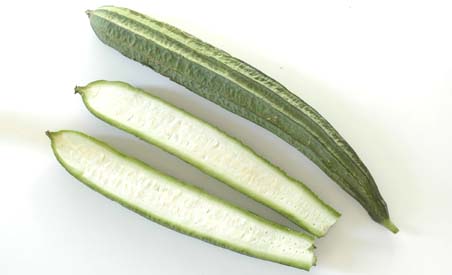
Ridge gourd has a firmer, less watery texture than zucchini, and the flavor is much more intense and sweet, where as Zucchini seems to be full of water and nothing else when cooked and too bland to taste. Given a choice, ridge gourd clearly comes out as the winner, taste wise. Though I dislike character less personalities in life, I do like the bland zucchini. It took some time but it won me over. In case of ridge gourd, I may have made complaining noises about other veggies but never about ridge gourd or ‘beerakaya’ we call it in Telugu. Be as curry or chutney or in dal, I relish ridge gourd in all forms. I even tried growing it here, when we were in Houston albeit unsuccessfully, not good seeds.
Here is a recipe of ridge gourd in tomato sauce, Vijay’s favorite and My Mother-in-law’s recipe:
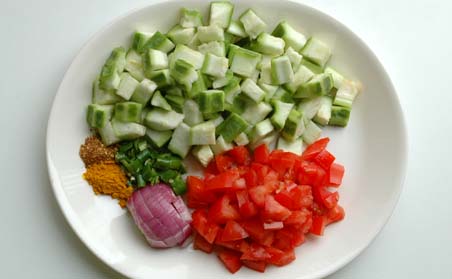
Recipe:
2 young looking, fresh ridge gourds
Scrape the skin and ridges, wash, then cut into bite size pieces
4 ripe juicy tomatoes – finely chopped
1 onion – finely chopped
4 green chillies
—————-
1 tablespoon of coconut powder
½ tsp of dhania(coriander) powder & turmeric
¼ tsp of salt – or to your taste
Popu ingredients – 1tsp each of mustard seeds, cumin, curry leaves & minced garlic
Preparation:
You know the drill. Heat peanut oil, do the popu, sauté onions, tomatoes and green chillies. Add chopped ridge gourd and all the seasoning. Stir to mix and cook, covered. Tomato juice and water that comes from cooked ridge gourd pieces is going to be enough to make the curry a stew/kurma type. So don’t add any extra water, unless you want a watery, thin version. Cook till ridge gourd pieces are tender and the sauce thickens. Serve it warm.
Though I have to say my favorite is always the dry curry recipe, that I posted a while back, I also make this sauced version sometimes, because Vijay likes it. Either as a sauce for pasta/with chapati/ or with rice, this curry tastes good. Sometimes, we do the dunking thing with toasted garlic bread. Good eat, any way you prefer.
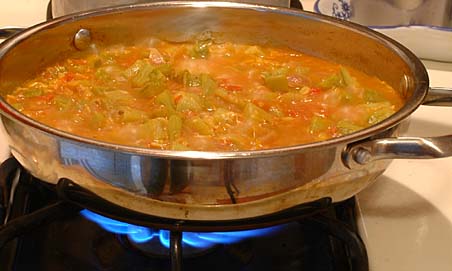
Recipe source: Attamma(MIL)
Another recipe with tindora (ivy gourd, dondakaya, Kovakku), this time with a sauce. Sauce is prepared from roasted sesame seeds, fresh coconut and dried chillies, sweetened with little bit of jaggery. Usually sesame sauce calls for the addition of tamarind, but in this case, slightly sour taste of tindora cancels the need for tamarind.
A different recipe, sweet and sour – because of jaggery and tindoras, nutty and nourishing due to sesame-coconut combination. A must try, for those of you who are interested in cooking up something new with tindoras.
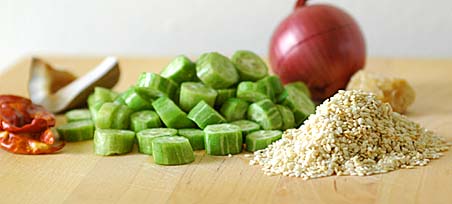
Recipe:
20 fresh tindoras – each, cut crosswise into rounds (3 to 5),
1 medium sized onion – finely chopped
½ cup sesame seeds
¼ cup powdered coconut – I used fresh coconut-oven dried
4 to 6 dried red chillies
1 tablespoon powdered jaggery (or to your taste)
½ teaspoon salt and turmeric
Popu or tadka ingredients
Preparation:
In an iron skillet, lightly toast sesame seeds, powdered coconut and dried red chillies. Cool and take them in a blender or food processor and make a smooth paste.
In a pan, heat one teaspoon of peanut oil, do the popu or tadka i.e. toasting one teaspoon each of mustard seeds, cumin, minced garlic and curry leaves
Add onion, saute a little bit, and then add round slices of tindora. Mix them once, cover and cook, stirring in between for 10 to 15 minutes on medium heat. Allow cooking tindora in its own moisture, sort of steam-saute.
When they are tender and giving off wonderful smell, add the sesame-coconut paste, jaggery, salt and turmeric. Add half glass of water. Stir to mix and cook them covered, until the sauce thickens. Serve warm with rice or chapati.
I have to say this curry tastes great with chapati/roti than with rice.
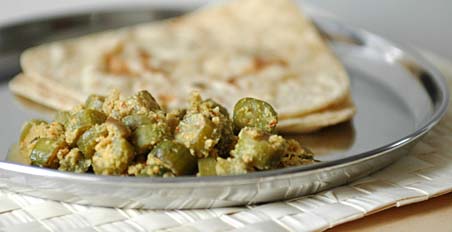
Ripe guava:
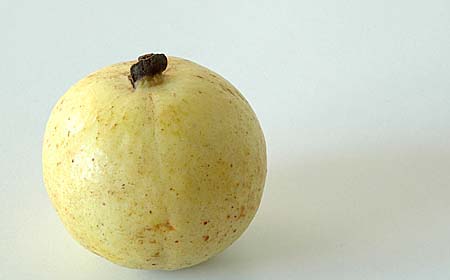
It’s has been a while since we saw and had a ripe guava. 6 years to be exact. They were not in season during our trips to Nandyala. But we got lucky in Toronto, Canada. Local Indian stores were carrying this precious Indian fruit and the real miracle is at a reasonable price.
One of life lessons, I learned is, its not good for health to feel nostalgic about home foods. But this fruit with its incredible fragrance, with just right amount of ripeness brought out symptoms of nostalgia. Eyes misted, mouth watered, brain couldn’t get enough of its smell and heart wanted more… .I don’t know when I’d have a taste of guava again, but for now, I enjoyed the fruit, feeling nostalgically delirious.
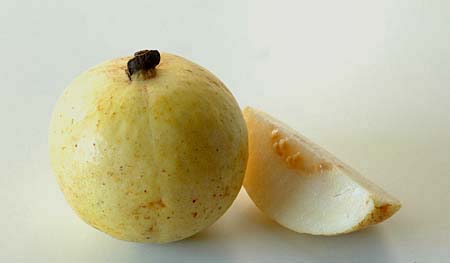
This cherished fruit with unique taste and fabulous fragrance when ripe is called Jamapandu in Telugu and ‘Guava, Amrud, Koiya Palam, Perakka and Peyara’ in other Indian languages. Ripening process makes the fruit go from hard to tender and skin colour also changes, from a shade of green to a shade of yellow. We usually eat the whole fruit including the skin and the tiny seeds, when ripe. Just sprinkle some salt, to give that perfect taste of salty sweetness. Pleasant but not flashy, both in looks and taste -that’s how I describe guava.
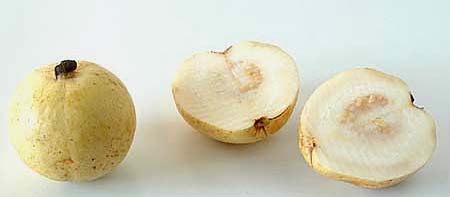
I am glad I was able to capture the image of ripe guava for my Indian kitchen series. Even though I gave up the idea of hosting ‘Indian kitchen’ here on my blog (very time consuming), instead, I created a Flickr group to share images of Indian ingredients and utensils so that food bloggers and foodies who don’t have blogs, but interested to participate, can share images. It can also used as a group pool, so that whenever we need a photo of some kitchen thing, we can link to the image in Flickr set, instead of doing google or yahoo image search. If you are interested, join the group and share your images of Indian kitchen.
My New Camera:

I didn’t know that I’d develop this much interest in cameras and photography. Vijay, who is a master in photography was more than happy to indulge me in my latest hobby, with the new Nikon D70s Camera.
Kittaya, our little darling, playing in snow. He is so excited to see the snow flakes falling and he tries to catch them all with his tongue.


Check out Kiri and the gang at Clare’s and also my new addiction‘Terri, the terrific’. Not only the cutest dog, he is quite a story teller too.
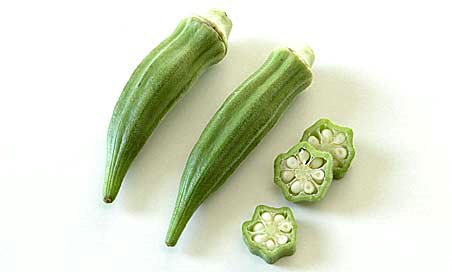
As a whole, okra looks handsome and wholesome.
Cut it open, you realise that you are dealing with one needy veggie. Like a toddler who hangs on to mother’s saree, okra clings to everything that is in sight. To the cutting board, to the knife, to the pot and it slips in your mouth too. No wonder it elicits strong reaction from people. I like okra and I don’t mind its clinginess because I know how to deal with it. I have few tricks and tips to make it less sticky. Keep in mind, I am talking about the fresh okra and not the frozen kind, which are hopeless to reform.
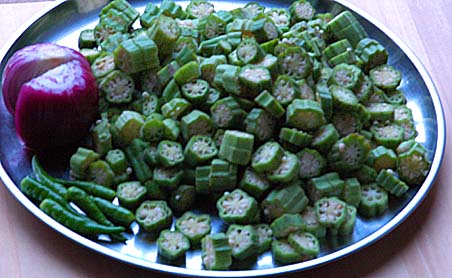
Recipe and some tips:
(For two, for one serving)
20 to 25 fresh, whole okra – washed thoroughly, then rubbed in a clean cloth, to remove all the moisture. This small step alone reduces the clinginess by 50%. After making sure they are clean and dry, slice each one, crosswise into half centimeter thick pieces. By now you may notice, touch of knife brings out the thick, viscous substance in okra. So in between cutting, periodically, wipe the cutting board and knife with a paper towel to remove the sticky stuff that’s accumulated.
1 medium sized onion – finely chopped
6 green chillies and 1 tbs of coconut – made into smooth paste
Turmeric and salt to your taste
And the usual ingredients of popu or tadka
Preparation:
In a wide pan or in a well-seasoned iron skillet, heat one teaspoon of peanut oil. Do the popu or tadka (toasting 1 tsp of each, mustard seeds, cumin, curry leaves and chopped garlic).
Add and saute onions till soft and brown. Then add the cut okra slices. Sprinkle in turmeric, salt, and fine paste of greenchilli-coconut. Mix them all once, allow them to cook for 5 minutes, covered on medium heat.
After 5 minutes, remove the cover and stir them once. Reduce the heat to medium-low and let them saute or cook openly. This is the time to show restraint. Do not stir and mix at all, at this stage. The more you stir and the more okra breaksdown and oozes clingy stuff. So don’t stir. Let it cook undisturbed for 15 minutes. As a result, round okra slices will be intact in shape and tender, lightly browned in the bottom and crunchy – perfection. Serve hot.
Tastes good with rice-dal combination and also with chapatis/rotis.
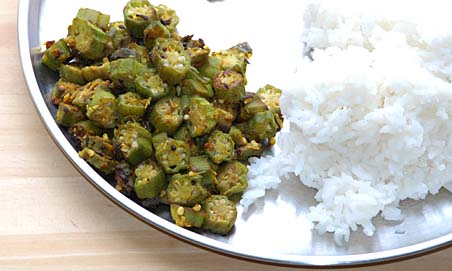
 Thank you my dear readers and fellow bloggers who nominated ‘Mahanandi’ for food blog awards. And also to judges of food blog awards and to Kate Hopkins of Accidental Hedonist, who is hosting and doing all the hard work of calculating the votes etc.,
Thank you my dear readers and fellow bloggers who nominated ‘Mahanandi’ for food blog awards. And also to judges of food blog awards and to Kate Hopkins of Accidental Hedonist, who is hosting and doing all the hard work of calculating the votes etc.,
I am very humbled and honored by your show of affection. Because of you, I am very proud to announce that Mahanandi is nominated in Best Recipes Category as one of the five blogs.
Voting to select the no.1 in each category is open now till Jan 18th. All are welcome to participate and I’d greatly appreciate your vote in this final process. Try as I may to show indifference to this whole process, I can’t help but feel happy that a nomination and an award, a sign of appreciation would bring.
I already voted for my favorites in each category and Barbara, you got my vote for ‘Best Post-Reader’s Choice’, congrats. Voting process seems to be legitimate and professional, can vote only once, in each category. We all enjoyed reading and cooking up recipes from food blogs, now is the time to show the support. Click here to Vote and have fun.
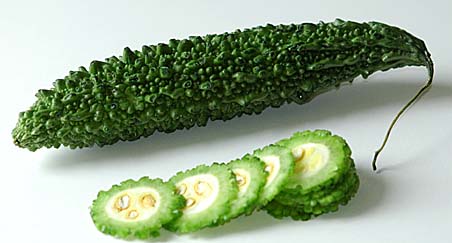
A perfect side snack, karela chips are crunchy, slightly bitter and spicy. A very different taste compared to potato chips but equally irresistible as an accompaniment to the regular meal of rice and dal.
I usually make them, slowly sauteing in a big pan for half an hour like that, until they turn crispy. Back in Nandyala, deep-frying the thinly sliced rounds of karela is the norm. Thanks to Kay and her recipe, I found a very easy way to make the karela chips without compromising the taste. Baking and broiling. Method is easy and the taste is superb.
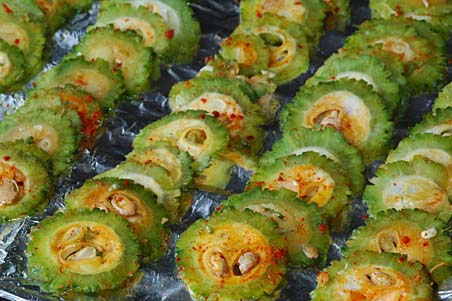
I followed kay’s recipe.
Washed 3 bitter gourds (Karela – Indian variety). Using a mandoline, sliced thin rounds. That’s easy. chuk..chuk.chuk.. Plateful of karela rounds. Tossed them in two teaspoons of peanut oil and sprinkled red chilli-garlic powder, salt, turmeric to my taste (1/2 tsp each). More tossing. Kept them for 15 minutes like that so that karela rounds can absorb the seasonings.
Arranged them neatly in rows, on a foil covered baking tray. Then baked them in a pre heated oven at 375° F for about 10 minutes, another 5 minutes under broil setting to make them extra crispy. I had to watch them closely during the broiling. They turn from crispy to black very fast, I didn’t want that. Total 15 minutes in the oven – the result was crunchy karela chips.
Thanks Kay for this wonderful recipe. Fabulous results without much sweat – Vijay and I both liked them very much.
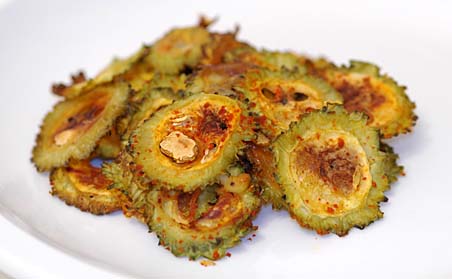
Bitter gourd (Karela) Chips.
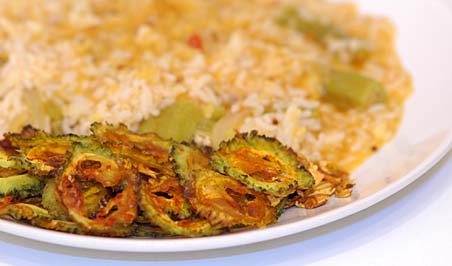
Karela chips with okra sambhar & rice
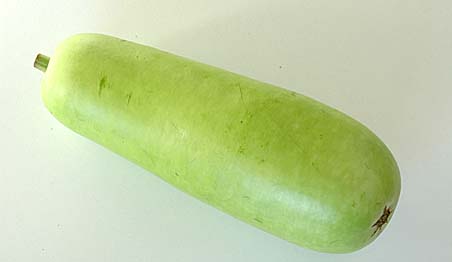
I remember the mock fights with my sisters using this lengthy, stout vegetable, when we were children. This vegetable was our makeshift club in our funny fights. There are other stories that I still could remember to this day related to this vegetable. My mother used to plant this vegetable every year in our backyard and the crop was surplus to our family… in those days I dreamt of making a lot of money by selling surplus produce, which never materialized. After some time we were tired of eating this vegetable and I tried to convince my mother not to plant this vegetable in vain. One year we had a crop of more than 200 of these and needless to say, if you were our neighbor during that time, you would have received some of these from us for free, you might have begged us not to sent any more too.:)
Sorakaya in Telugu and bottle gourd, lauki, dudhi or lau in different Indian languages, here is one of my mother’s recipe with bottle gourd. Not a lot of ingredients, very simple and basic – tastes good only with chapatis and jowar roti.
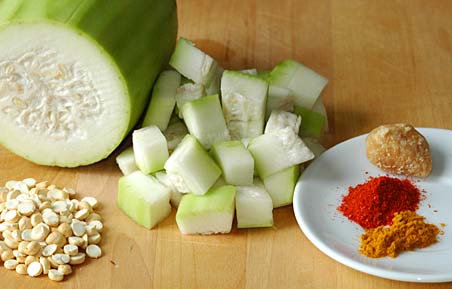
Recipe:
Bottle gourd – medium sized – outer skin peeled, then cut into cubes.
1 cup of dalia(pappulu, pottu kadalai) – finely powdered
Dalia or Pappulu is a type of dal made by roasting the chana dal or bengal gram
1 teaspoon of red chilli powder
1/2 teaspoon each of salt and turmeric
Jaggery, one tablespoon or to your liking
Heat one teaspoon of peanut oil in a big saucepan, toast mustard seeds, cumin and curry leaves. Add the bottle gourd cubes. Cover and cook them in their own moisture. When they are little bit softened, add the finely powdered dalia (pappulu), red chilli powder, salt, turmeric and jaggery. Add half glass of water and mix them all thoroughly, without any lumps. Cover and cook for about 10 minutes until the sauce thickens and bottle gourd pieces turn soft.
Serve hot with chapatis or with jowar(Sorghum) roti.
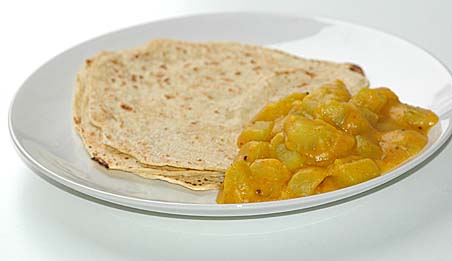
Recipe source: Amma
Note to the reader: The sauce to this curry is mainly made of dalia powder. If you think, there is not enough sauce, powder some more dalia and add it to the curry and adjust the seasoning like salt and jaggery to your taste.
We spent New Year’s Eve and half of today in Pittsburgh, at our dear friends Rama and Bhargavi’s house. To celebrate their new baby Vivek and also new year, they hosted a party, yesterday night at their beautiful home. A party of friends and children, the total number was 30. Second time parents of 3 month old baby, as you can imagine, how tired and sleepless, they must be. Even then, they insisted and prepared a splendid meal for all of us, declining our offer of help. We had a great feast and a fine, dandy time. Thank you dear Dadis.
With their permission, here are some photos. The last images we took in 2005 and what a way to remember 2005!

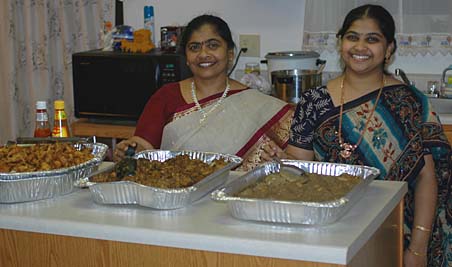
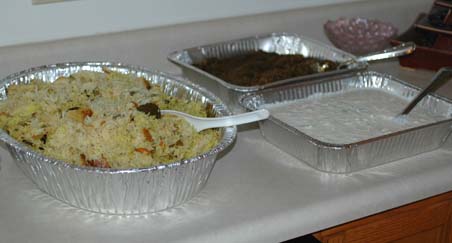
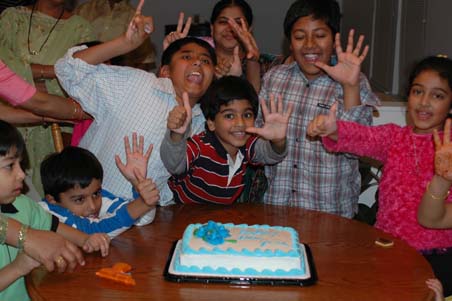

This is my entry to New Year’s Swap hosted by lovely Cannella, Chef Melissa, Elviria and Marcela. No recipes but only images, I hope that’s ok.
Dear family, friends, fellow bloggers and readers

I was tagged by Lulu of Manhattan, who recently moved to London and with a new blog Lulu Loves London, VKN of My Dhaba and Kimbie of Chocolate-Chip to list my 10 favorite foods. Tough to narrow it down to only 10, when there are so many food groups and cuisines to choose from. So I am going to keep it short and simple and list 10 images of my absolute food favorites I blogged this year.










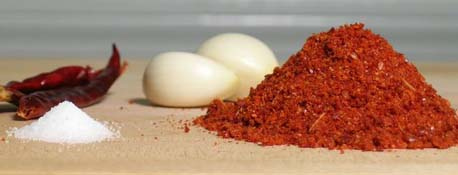
Thanks Lulu, VKN and Kimbie, I had fun saying goodbye to 2005 through images of my favorites foods.
If you are interested, feel free to tag yourself and write about your favorite foods like Paul of KIPlog fame, judge for this year’s 2005 Food Blog Awards, did.
Do you remember my post about stuffed brinjal curry with peanuts and sesame seeds? In that post, I also mentioned different kinds of stuffing that I know. Here is another type of stuffed brinjal curry, I am calling it by Hindi name – ‘Bagara Baingan’ – This time with purple brinjals, stuffing made with dals and fresh coconut and cooked in a pan. The stuffing doesn’t taste very good when pressure-cooked. So for this kind, I make it in a pan, like how they do it back home.
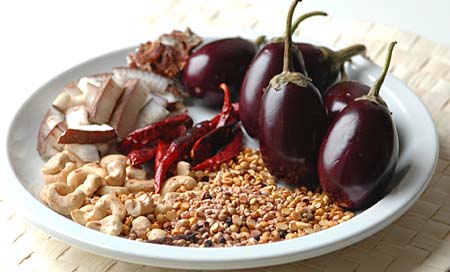
Recipe:
Small, fresh, young, blemish free brinjals – 8 to 12
Roasting for stuffing and gravy:
Chana dal and urad dal – quarter cup each
Black peppercorns and cloves – 4 to 6 each
Dried red chillies – 6 to 8
Cumin, coriander seeds & methi seeds – 1 teaspoon each
Roast them in an iron skillet till golden. Mix them with
Fresh or dried coconut – 1/2 cup
Tamarind juice and powdered jaggery – 1 tablespoon each
Salt – 1/2 teaspoon
My addition: One fistful of roasted cashews
Ginger garlic paste and roasted red onions can be added to this mix.
Make a smooth paste of all the above ingredients without adding any water. Divide it into two portions. One for stuffing the brinjals and the other portion is for making the gravy.
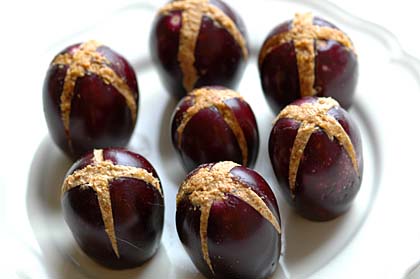
Stuffing:
1. Wash to clean up the wax coating on brinjals. Neatly cut and remove the stem of each brinjal.
2. Starting at opposite side of stem, make a plus (+) shaped cut towards the stem side, but not all the way through. (See the photo above, to get an idea)
3. Gently separating the brinjal petals, fill the narrow gap with the prepared paste.
Cooking:
1. In a big, wide, flat pan – heat one tablespoon of peanut oil, do the popu or tadka (toasting one teaspoon each of mustard seeds, cumin, curry leaves and minced garlic).
2. Arrange the brinjals – stuffing side up, neatly in rows. Cover and cook them in their own moisture for about 15 to 20 minutes on medium heat or until they soften. The younger the brinjals, the faster they cook.
3. Once you are sure that brinjals are tender and cooked, remove them carefully without disturbing shape onto a serving dish.
4. Pour the remaining paste that was kept aside to the pan. Mix it with half glass of water. Sprinkle in turmeric and adjust the salt, spice (red chilli), sour (tamarind) and sugar to your taste. Cook for another 10 to 15 minutes on low medium heat, until the gravy thickens.
5. Now put the brinjals back into the thickened gravy. Cook for another couple of minutes.
With rice or roti, this curry is a party favorite and a crowd pleaser.
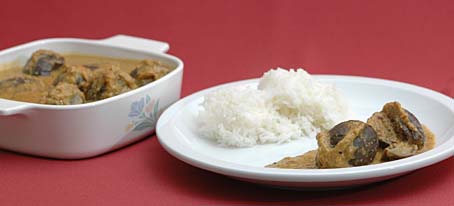
Bagara Baingan with Rice ~ Our dinner today.